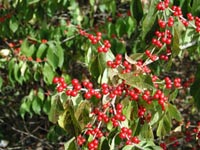Resource Library
Plant of the Week: Amur Honeysuckle
The University of Arkansas System Division of Agriculture does not promote, support or recommend plants featured in "Plant of the Week." Please consult your local Extension office for plants suitable for your region.
Plant of the Week
Amur Honeysuckle
Latin: Lonicera maackii

Amur honeysuckle is a deciduous shrub growing 8 to 10-feet tall with numerous branches arising from a central crown. It is twiggy by nature and grows in what we refer to as a vase-shaped habit, the same general outline as an American elm but considerably smaller. In the summer the oppositely arranged, entire margined, 2 to 3-inch long leaves end in a narrow point, but are otherwise unremarkable.
In April and May the 1-inch long, honeysuckle-shaped white flowers are produced along the stems after the leaves emerge. As the flowers age they change to a creamy yellow. There is no noticeable fragrance. Following the flowers come berries, lots of berries. The translucent red, pea size berries appear in October and persist until late winter. Birds seem to use them as a backup food source, shunning them if something more to their liking is available.
The Amur Honeysuckle was named after its discoverer, David Maack (1825-1886). Maack was a naturalist and explorer who, in the 1850's, tromped through the mountainous borderland between northeastern China and Russian Siberia looking for things of scientific interest. Many of his plant introductions came from the Ussuri River watershed, a major tributary of the Amur River, which is the boundary between Russia and Manchuria.
From hints given by the complete Latin name, I surmise that Maack sent his botanical discoveries to the Imperial Botanic Garden (today the Komarov Botanical Institute) in St. Petersburg. There the botanist in charge was C. J. Maximowicz who wrote extensively on the flora of his homeland and introduced a number of Japanese plants into cultivation. While interesting background, this still doesn’t explain the Amur honeysuckle growing in our woodlands.
I found another clue in the journal of a Fayetteville nurseryman, Jacob Smith (1799-1878). Smith, a native of Denmark, immigrated to Fayetteville in 1836 and purchased 160 acres of land two miles north of the then small settlement in northwest Arkansas. He was a nature lover who recorded the comings and goings of birds, when flowers bloomed and lots of weather observations affecting his garden, a place the locals called " Smith’s Flower Garden." His journals are preserved in the Special Collections of the Mullens Library at the University.
On May 14, 1866 is his notation "China Honeysuckle in bloom." Smith accumulated about 150 species of plants before the Civil War, no small feat for the western outpost Fayetteville must have been at the time. One of his favorites seems to have been honeysuckles, for he grew at least 10 different kinds. John Fitzpatrick, the director of Historic Plants at Monticello, identified Smith’s "China Honeysuckle" as the vining plant we now call Japanese Honeysuckle.
But I wonder if perhaps the plant Smith grew was instead the Amur Honeysuckle. Several of the other plants Smith grew in his nursery were growing in his Fayetteville garden about 10 years after they were brought into cultivation by various plant explorers. This quick distribution of "new plants" indicates the well-oiled distribution system that existed for plants in mid-19th century America.
The widespread distribution of Amur honeysuckle in our woodlands indicates that birds spread it freely, and that it has been here for a long time. Gardeners no longer grow this troublesome weed-plant and are only interested in seeing it gone. Fortunately, the plant is remarkably shallow rooted and even fairly large plants can be grubbed out readily.
By: Gerald Klingaman, retired
Extension Horticulturist - Ornamentals
Extension News - January 24, 2003
The University of Arkansas System Division of Agriculture does not maintain lists of retail outlets where these plants can be purchased. Please check your local nursery or other retail outlets to ask about the availability of these plants for your growing area.